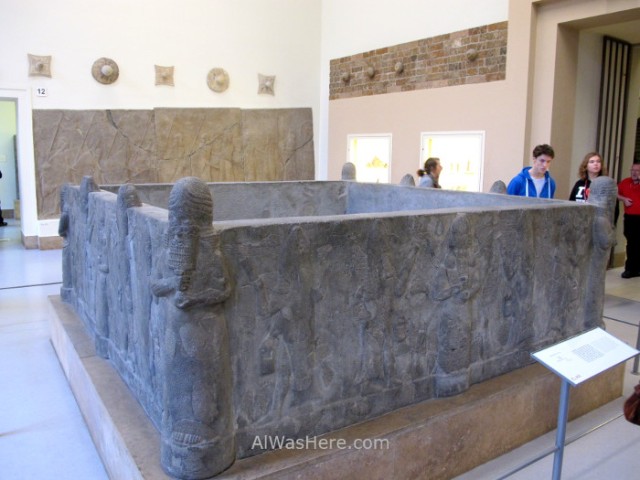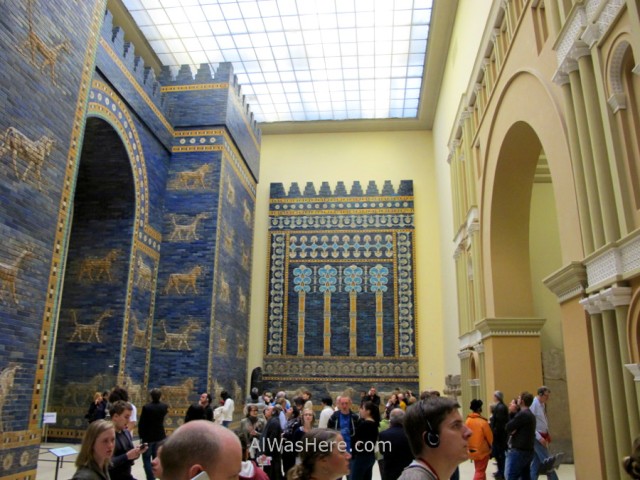Updated January 9, 2019
Berlin has some excellent museums, and among these, Pergamum is my favorite, because it is not the typical museum full of paintings and statues, it is the only one I have seen that has almost complete buildings in it.
This museum basically has 4 rooms:
- In one there is an entire Greek temple inside.
- In another is the entrance to a Roman market.
- In another is one of the gates of Babylon.
- And in the last one is part of the wall of an Arab palace.
Actually there are many more rooms, but the others you will hardly remember because they do not differ from those of other museums.

SCHEDULES, PRICE AND LOCATION
It’s on Museum’s Island. For those not staying in Mitte, the nearest train station is U6 (Friedrichstraße) and subway stations are S1, S2, S25 (Friedrichstraße) and S5, S7, S75 (Hackescher Markt).
- Open daily from 10 am to 6 pm (until 8 pm on Thursdays).
- Adult admission:
- Simple: € 19.
- Pass for all the museums of the Island: € 18, absolutely recommended if you intend to visit more than one.
- 3-day pass that includes the 30 main museums in Berlin: € 29.
Tickets can be purchased on their official website … if you read German, they are like this…
PERGAMON ALTAR
And how do you explain that admission to a single museum is more expensive than admission to the 4? The only logical explanation is that, first and foremost, the altar is CLOSED UNTIL THE END OF 2023 BECAUSE OF RESTORATION, even it has been closed since 2016. Being the most popular museum, and have almost a third closed, visitors do not fit, so instead of cheapening the price of other museums to encourage tourists to disperse, they have raised the price of this. Until not long ago adult admission cost € 12.
A pity, because, although it is not my favorite, if you close a room of a museum that practically only has 4, it’s not like I’m going to like that. Let’s see, I know you warn me before entering, but why don’t you charge me € 9? because it’s not so cheap, you know. Anyway, luckily I have photos because on my first visit, in 2012, it was open, and I would swear that it was in perfect condition.

Pergamum was a city of ancient Greece, located in a region a few kilometers off the western Mediterranean coast where now Turkey is. Its ruins are still visible and are close to the modern city of Bergama. The altar of Pergamum is the masterpiece of the acropolis of that city and was built approximately in the year 180-160 BC. In 1864 most of it was buried, but some fragments, sculptures and reliefs were exposed and the villagers, who did not understand much of millenary art, were dedicated to destroy the statues to obtain lime and the building to get materials for their houses. The German archaeologist who was investigating the area almost had a stroke when saw this, so after years of negotiation, the Turkish government allowed the German to excavate the area if they pay for it, and this way they bought the temple.

The room presents a reconstruction of the altar. The sculptures of its frieze are considered one of the greatest masterpieces of Greek art. They portray the gods of Olympus fighting against the giants.

MILETUS MARKET GATE
Miletus was another Greek city also settled near the western coast of what is now Turkey, further south than Pergamum. In 600 BC it was even said that it was the richest and most prosperous city in the empire. The market gate was built between 120 and 130, under Roman rule.

Between the tenth and eleventh centuries an earthquake toppled it. The German government buys, as with the previous building, the rights of excavation and recovery of all the material in 1903. It is really impressive to see the work and dedication that were used to build something as everyday as the gate of a market. Unlike the altar, where almost all the exposed material is original, the market gate required more severe reconstruction, which generated criticism to the museum, since it was exposed as original while a large part of it was not.


ISHTAR GATE
This is my favorite room, spectacular, fascinating and above all different; we have all seen a Roman or Greek temple before, but Mesopotamian architecture? That is not at all common, and it is a shame, the few buildings that are conserved are not in good condition and most are in Iraq, a country not recommended for tourism nowadays.

The majesty of the gate (so called by the goddess Ishtar) covered in dark blue glazed bricks, with reliefs of bulls and dragons, is impressive and imposing at the same time and even more so when you are explained that this is not really the gate, but the before-gate. The real gate was immediately behind, it was wider and its towers were higher, so much that they have it in the museum, but they were not able to reconstruct it for a matter of space (which I find outrageous, by the way). But then they explain that it is only the before-gate of one of the 8 gates that gave access to Babylon, and before reaching it, anyone who wanted to enter the city had to go through a processional corridor, of which 113 meters have been reconstructed, formed by two walls covered with reliefs of lions, bulls and dragons and blue bricks for hundreds of meters, crowned by archers.


If it is certainly sensational today, how it must have been more than 2,500 years ago, when it was built.
In this part of the museum there are also other interesting findings, such as the the oldest in the world cuneiform writing tablets, about 6000 years old.

FACADE OF MSHATTA PALACE
This palace dates back to the 8th century and was built, like many others in its time, in an eastern desert area of what is now Jordan, about 30 km south of the current capital Amman. It was never finished, as the caliph who ordered its construction was killed, and later part of the work was destroyed by an earthquake.

The exposed one in the museum is a small section of the facade, the one that surrounded the main entrance; most of the wall is not decorated and continues where it was built. It was found in 1840, and was given by the Ottoman Sultan to Emperor Wilhelm II of Germany. The reliefs are excavated in the stone, and show figures of animals and plants.

Also relevant in this area dedicated to Islamic art is the Aleppo room, from the house of a rich merchant of that city in the seventeenth century, with its luxuriously painted wooden panels.

Pingback: MUSEO DE PÉRGAMO – Al Was Here
Pingback: BERLIN – Al Was Here
Pingback: BERLIN IN 24 HOURS – Al Was Here
Pingback: EPHESUS – Al Was Here
Pingback: BERLIN IN 24 HOURS – Al Was Here